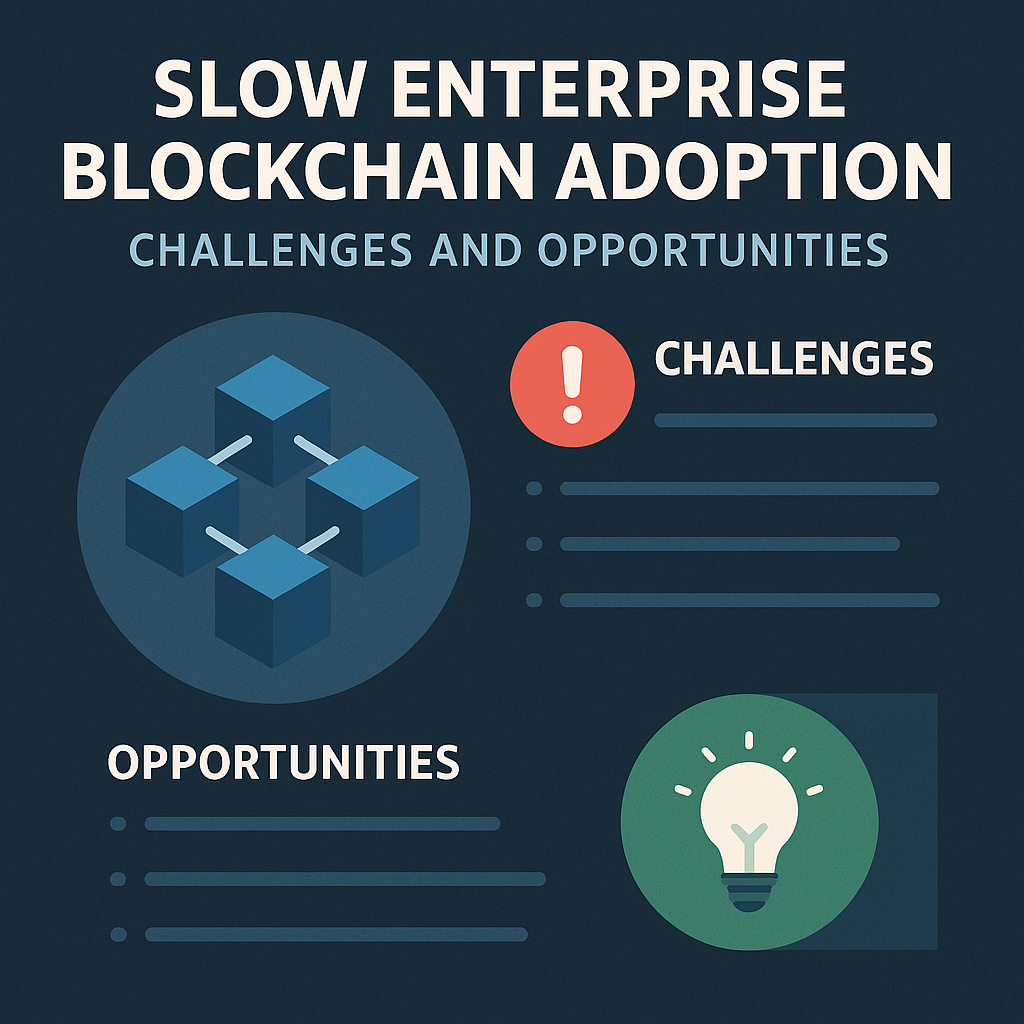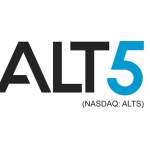NFT & Blockchain
Slow Enterprise Blockchain Adoption: A Deep Dive Into Challenges And Emerging Opportunities

Introduction
Blockchain technology has been one of the most hyped innovations of the past decade, promising a future of decentralized systems, heightened security, and improved operational efficiencies. Despite this enthusiasm, blockchain adoption among enterprises has been slower than many anticipated. Enterprises across sectors like finance, healthcare, supply chain, and energy initially announced pilot programs and experiments, yet full-scale deployments remain rare. However, this sluggish pace should not be interpreted as a failure. Instead, it reveals the realities of integrating transformative technology into complex, risk-averse environments. More importantly, it unveils enormous opportunities for businesses that are willing to engage in strategic, patient development.
Understanding Blockchain’s Initial Hype Cycle
The early 2010s marked the rise of blockchain’s mainstream recognition, largely driven by Bitcoin’s success. Enterprises soon realized that blockchain’s applications extended beyond cryptocurrencies. Terms like “trustless systems,” “immutable ledgers,” and “smart contracts” began to capture the imaginations of executives. Blockchain was heralded as a solution for everything from food traceability to interbank transactions. Gartner’s hype cycle placed blockchain at the “Peak of Inflated Expectations” around 2018, suggesting that many businesses were adopting blockchain because it was seen as a mandatory step toward innovation. However, the real complexities and integration challenges were often underappreciated during this phase.
Why Enterprise Blockchain Adoption Has Been Slow?
Technological Immaturity
Blockchain technology, especially in its early days, lacked the maturity necessary for enterprise-grade applications. Scalability issues were rampant, with major public blockchains like Ethereum and Bitcoin facing transaction bottlenecks and high fees. Early blockchain platforms could not handle the transaction volumes or processing speeds required by large organizations.
Lack of Standardization
Another significant obstacle has been the lack of standardization. Enterprises typically require clear protocols, governance models, and interoperability across platforms to justify the risk and investment. However, the blockchain ecosystem is highly fragmented. Different blockchain networks use varying consensus mechanisms, token standards, and security protocols, making it difficult to establish a uniform industry approach.
Regulatory Uncertainty
Regulatory frameworks surrounding blockchain remain ambiguous in many countries. Issues related to data privacy, financial reporting, and compliance with standards like GDPR create barriers for companies wary of future legal challenges. Without regulatory clarity, enterprises have been hesitant to move beyond pilots and proofs of concept.
Integration with Legacy Systems
Enterprises have complex IT infrastructures that are not easily adaptable to blockchain integration. Legacy systems are deeply embedded within organizational processes, and retrofitting blockchain solutions often demands massive overhauls or complex middleware, raising costs and complicating adoption timelines.
Skills Shortage
Another reason adoption has been sluggish is the shortage of blockchain professionals with the right blend of technical, business, and regulatory expertise. Developers who can design scalable, secure enterprise blockchain solutions are in high demand but in short supply. This scarcity extends project timelines and increases costs.
Misalignment of Use Cases
Many early blockchain pilots were technology-driven rather than business-driven. Companies were excited to experiment but often lacked clear, scalable use cases that would genuinely benefit from blockchain’s unique properties. This misalignment led to projects that were technically interesting but offered minimal business value.
The Silver Lining: Opportunities Hidden In Slow Adoption
While the slow pace has frustrated some observers, it has opened critical windows of opportunity for forward-thinking enterprises. Businesses that invest wisely now can establish a first-mover advantage once the technology matures.
Building Sustainable Solutions
Organizations now have the chance to step back and design blockchain solutions with true sustainability in mind. Instead of rushing to market, they can ensure that their blockchain applications are scalable, secure, and aligned with actual business needs. The companies that succeed will not be those that adopt blockchain first, but those that adopt it best.
Enhanced Collaboration
The slower pace of adoption has encouraged collaboration among enterprises, academic institutions, and government bodies to develop standards, interoperability frameworks, and shared platforms. These collaborations can dramatically lower the risks associated with blockchain deployments by ensuring consistency and mutual benefit.
Regulatory Shaping
Early enterprise blockchain adopters have an unprecedented opportunity to help shape regulatory frameworks. By working with policymakers and industry groups, enterprises can ensure that the evolving regulatory landscape supports rather than inhibits innovation.
Training and Talent Development
Organizations that invest now in training and talent acquisition can position themselves as leaders in the future blockchain economy. Rather than competing in an overheated hiring market, businesses can develop in-house blockchain expertise aligned with their strategic goals.
Strategic IP Development
Patents and proprietary blockchain technologies developed during this lull could yield enormous strategic advantages. Companies that build robust intellectual property around blockchain applications will have valuable assets when mass adoption finally accelerates.
Industries Most Likely To Benefit From Enterprise Blockchain
Supply Chain and Logistics
Blockchain’s potential for real-time tracking, provenance verification, and fraud prevention is well established in supply chain industries. Companies that start building now can solve persistent problems in transparency and efficiency, setting new industry standards.
Healthcare
Healthcare organizations that develop blockchain systems for patient data management, clinical trials, and drug traceability can gain enormous trust and operational advantages. With increasing data privacy regulations worldwide, blockchain’s auditability and security properties become even more critical.
Financial Services
While cryptocurrencies have dominated headlines, financial institutions quietly explore blockchain for clearing and settlement, digital identity, and trade finance. Banks that invest in enterprise blockchain today could redefine the structure of cross-border payments and credit risk management tomorrow.
Energy and Utilities
Blockchain offers innovative models for peer-to-peer energy trading, carbon credit verification, and decentralized energy grids. Early movers could capitalize on growing demand for sustainable, transparent energy ecosystems.
Government and Public Sector
Blockchain provides a secure framework for land registries, voting systems, and social welfare distribution. Governments are inherently cautious but those who act now could set global examples in digital transformation.
The Future Enterprise Blockchain Stack
The enterprise blockchain stack is becoming more modular and sophisticated. Future blockchain architectures for enterprises will likely include:
- Layer 1 and Layer 2 scalability solutions that enable high transaction throughput.
- Interoperability protocols such as Polkadot and Cosmos.
- Privacy-preserving technologies like Zero-Knowledge Proofs.
- Hybrid blockchain models combining public and private networks.
- Blockchain-as-a-Service (BaaS) offerings from major cloud providers.
Companies preparing now by experimenting with these components will find themselves well ahead of competitors when mainstream adoption accelerates.
Strategic Recommendations For Enterprises
Prioritize Use Cases with Real Business Value
Firms should identify pain points where blockchain’s decentralized, immutable, and transparent nature offers clear benefits over traditional systems. Successful use cases often involve multiple stakeholders, trust issues, and data sharing complexities.
Start with Permissioned Blockchains
Private or consortium blockchains offer more control, better performance, and easier compliance with regulatory requirements. Enterprises should leverage permissioned blockchains to pilot projects before venturing into public chain environments.
Partner Smartly
No organization should attempt blockchain adoption alone. Strategic partnerships with technology providers, industry consortia, academic institutions, and even competitors can dramatically increase the chances of success.
Develop a Regulatory Strategy
Businesses must proactively monitor the evolving legal landscape and engage with regulators early. Blockchain strategy should include compliance frameworks for data protection, financial services regulation, and tax reporting.
Cultivate In-House Expertise
Blockchain is not a plug-and-play technology. Enterprises should invest in training, cross-functional teams, and leadership education to foster a culture that understands and leverages blockchain effectively.
Conclusion
Slow enterprise blockchain adoption is not a sign of failure but a reflection of blockchain’s profound complexity and disruptive potential. Enterprises that understand the reasons behind the cautious approach are better positioned to take advantage of the resulting opportunities. As the technology matures, companies that have invested in sustainable solutions, partnerships, regulatory engagement, and talent development will emerge as leaders in a new era of decentralized digital infrastructure. The next phase of blockchain’s journey will not be led by hype but by practical, powerful, and profoundly strategic implementations.
Enterprises have a unique chance to influence, innovate, and invest in blockchain at a time when the technology’s greatest transformations are still on the horizon. Those who seize this moment will not just adapt to the future of business—they will help shape it.










